- Cooling and Ventilation Equipment
- 0 likes
- 1633 views
- 0 comments
Water Cooled Chiller Selection Tips
Chiller: The Water-Cooled Chiller is, in fact, the heart of cold water (7–12 °C) supply systems in industrial air conditioning and refrigeration systems that operate based on a vapor-compression refrigeration cycle—depending on the application.
The Water Cooled Chiller supplies cold water to the cooling coil of fan coil units and air handlers. An overall comparison of water-cooled and air-cooled chillers shows the water-cooled type to be much more efficient. However, air-cooled chillers do not require water and are free of the complications of precipitation in the cooling circuit, thus extending the service life of the AC equipment. Furthermore, the function of air-cooled chillers is not interrupted by disruptions in the water supply.
Click to view brands, models, and different types, find out the price, and Buy A WATER COOLED CHILLER.
The Refrigeration Cycle in a Water-Cooled Chiller
This type of chiller operates based on the vapor compression refrigeration cycle and comprises an evaporator, a compressor, a condenser, and an expansion valve.
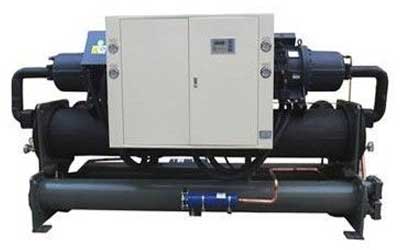
In a Water Cooled Chiller, the gaseous refrigerant is first compressed before entering the shell of the condenser where it exchanges heat with the water running in the condenser coil and transforms into a liquid. The pressure and flow rate of the liquid refrigerant are then reduced when passing the expansion valve before entering the evaporator coil where it again transforms into gas in an endothermic process. Due to the endothermic nature of refrigerant evaporation in the evaporator coil, the water running through the shell is cooled down to the desired temperature and then directed to the fan coil units and air handling units by the circulator pumps. On the other hand, the gaseous refrigerant coming from the evaporator is drawn into the compressor, continuing the refrigeration cycle.

The condenser and evaporator of the Water Cooled Chillers are, in fact, heat exchangers that can be of either shell-and-tube or plate types that the customer is free to choose from.
Despite the advantages of a plate heat exchanger (including high heat exchange rate, large surface area, compact size, and low price), water-cooled chillers often integrate shell-and-tube heat exchangers due to the complications with scaling over the heat transfer surface during the operation of plate heat exchangers.
Flooded chillers have been introduced recently that run the gaseous refrigerant through the tubes of the shell-and-tube heat exchanger and water circulating the tower through the shell of the condenser. Furthermore, the evaporator of flooded chillers passes the water circulating the AC system through evaporator coil tubes but the gaseous refrigerant through its shell.
It is important to note the difference between the nominal and actual capacities of the chiller—particularly, considering the local design outdoor summer temperature. Further, note whether the condenser and chiller heat transfer surface area—as determining factors—at the claimed capacity (length, size, and the number of tubes used in the condenser and the evaporator) are sufficient.
In general, to calculate the required chiller capacity in a project, based on the exact total refrigeration load, facilities engineers take into account the amount of required cold water and safety factors for the correct function of the chiller in addition to such parameters as the climatic conditions (ambient temperature), the design outdoor summer temperature, elevation, relative air humidity, building purpose (design indoor temperature), type of incorporated materials and the facade, orientation of the building relative to the sun angle, number of residents and small or large electrical equipment in the building. However, as a rule of thumb (phase 1 calculations), the required nominal capacity for residential and office buildings in a climate similar to Tehran can be estimated by 4 tons of refrigeration per 100 square meters of effective floor area. Further, before determining the final capacity and selecting a chiller, contact our specialists at DamaTajhiz for consultation and to control the refrigeration load's estimations for accuracy.
Advantages of Water Cooled Chiller Over Air Cooled Chiller
Despite some loss of water in their cooling towers, Water Cooled Chillers are superior to air-cooled chillers due to their higher Coefficient of Performance (COP), better control over the temperature of the condenser output water, lower initial investment (up to 50%), lower power consumption, facility of repair and maintenance.
Technical Information for Water-Cooled Chiller
The operating temperature of the chiller in AC systems is the temperature of chilled water leaving the evaporator that shall never fall below 7 °C.
Further, the temperature of the water returning to the evaporator at the peak system load must be nearly 5 degrees hotter than the water leaving the evaporator (moreover, it must be noted that the anti-freeze thermostat is often adjusted 4 degrees higher).
In all Water Cooled Chillers, the thermostat is installed at the water inlet to the evaporator, whereas in absorption chillers, it is installed at the outlet of the evaporator due to the delay in the function of the system.
The function of the multi-stage evaporator thermostat in the chiller: The chiller system can be controlled according to the temperature on which the slow-opening thermostat is adjusted by using 3 or 4-stage thermostats depending on the type of equipment, number of compressors, number of chiller circuits, and even the unloader system installed at the outlet of the evaporator.
Installing an unloader system on the compressor of the chiller can reduce power consumption when the refrigeration load decreases. Capacity control, or the unloader mechanism, is used to reduce the load during start-up and control the capacity during operation proportionately to the required refrigeration, which extends the service life of the equipment and increases its efficiency, thus considerably reducing the costs of energy consumption and maintenance. Unloading the compressor in proportion to the reduction of the load exerted on the system not only reduces the power input to the compressor but also decreases the stress on the motor and compressor due to sequential start-up and shut-down.
Installing a flow switch is necessary at the water outlet of the Water Cooled Chiller to the cooling tower to automatically shut the chiller down when the water pumps of the tower cease operation. For the correct, safe function of water-cooled chillers, a flow of water must be established in the condenser and the evaporator of the chillers. As a result, to prevent hazards of condenser or evaporator running dry, flow switches are needed in the output water circuit not to allow the tower pumps and chiller compressors to start.
In air conditioning systems, typically, the water enters the tower (from the Water Cooled Chiller) at 33–35 °C and leaves it for the condenser at 28–30 °C. In other words, the range (the difference between the entering water temperature and the leaving water temperature) is approximately 4–6 °C.
Four Technical Issues About Water Cooled Chillers
- Refrigerant superheating in the intake line of Water Cooled chillers
- Condenser subcooling in Water Cooled Chillers
- Doing a pump-down in Water Cooled Chillers
- Descaling and pickling Water Cooled Chillers
Types of Compressors in Water Cooled Chiller
The compressor is, in fact, the heart of a Water-Cooled Chiller and must be selected carefully for its impact on the performance of the equipment. The different types of compressors used in Water Cooled Chillers include scroll, screw, reciprocating, rotary, and centrifugal compressors that each come with their unique set of upsides and downsides (covered in FAQ). Therefore, the number, capacity, type, and manufacturer of the compressor, a main component of the chiller, must be taken into account (customers can ascertain the purchased chillers have never been used before and find out their date of production by registering their serial numbers at the manufacturer’s website).
The compression mechanism of the gaseous refrigerant is different in compressors integrated into Water Cooled Chiller. The compressors are classified into the five, previously-discussed, groups:
- Reciprocating compressors
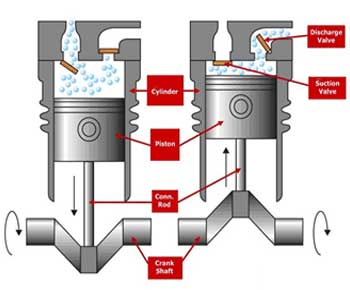
- Screw compressors
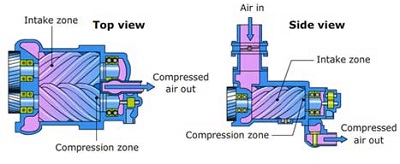
- Scroll compressors
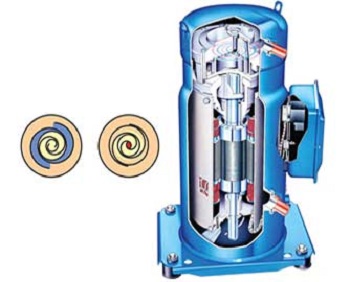
- Rotary compressors
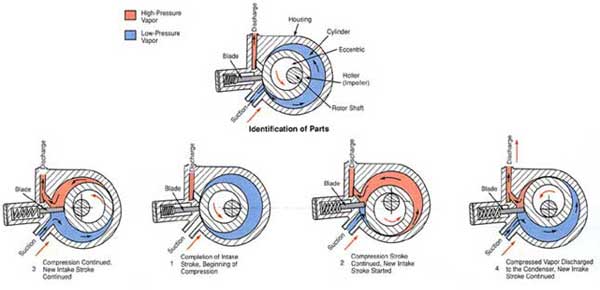
- Centrifugal compressors
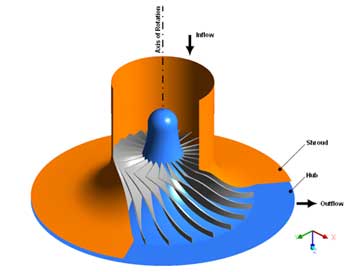
Centrifugal compressors (dynamic) are substantially different from the first four types of compressors in the list (positive displacement) in their working principle. In a positive-displacement compressor, a certain amount of gas is continuously reduced in volume by a piston, spiral, screw, or rotation, increasing the vapor pressure. Meanwhile, in a centrifugal compressor, the gas is compressed as a result of being accelerated by the rotation of an impeller followed by the reduction of its velocity in a diffuser. Centrifugal compressors are used in large-capacity applications.
Types of Compressors based on Casing Enclosure
- Hermetic compressors
- Semi-hermetic compressors
- Open compressors
In hermetic compressors, the electric motor and the compressor are placed in an enclosed casing that cannot be opened for maintenance. As a result, this type of compressor is used in low-capacity applications. In a semi-hermetic compressor, the motor and the electric motor are enclosed in a two-piece casing. In other words, the motor and the compressor are in separate, distinct parts of the assembly. Such compressors come with mid-range capacity, which is more than a hermetic compressor. In an open compressor, the electric motor is separated from the casing enclosure and connected to it by a coupling. Such compressors are available in high capacities.
The Condenser in Water Cooled Chiller

In air-cooled condensers, the air serves as the cooling agent for distilling the refrigerant, whereas water is used to cool the refrigerant in a water-cooled compressor. Moreover, evaporative condensers use both air and water. Although the temperature of the passing air increases to some extent in an evaporative condenser, the refrigerant is distilled by the evaporation of the water sprayed on the condenser and air serves to promote evaporation by removing the resulting vapor. Water Cooled Chillers often use the second type of condenser. Depending on the chiller's model, design, and capacity, condensers can be either water-cooled or air-cooled. The water-cooled condenser of a chiller is often of the shell-and-tube or plate type and requires a cooling tower integrated into the refrigeration circuit for the water to exchange heat with the refrigerant and cool down.

The Expansion Valve in the Water Cooled Chiller
The expansion valve, by creating a pressure drop across the path of the refrigerant running to the evaporator, transforms liquid refrigerant to hot gas and, then, to cold gas. Depending on its design, the chiller expansion valve can be thermostatic, compression, or electronic.

The Evaporator in Water Cooled Chiller
The evaporator, in cooling systems, is a heat exchanger that helps transfer heat from water to the gaseous refrigerant. In a Water Cooled Chiller, the evaporator operates with the cold gas passing the expansion valve, collecting heat from the water. The cooled water then runs to the cooling coil of the fan coil or air handling units for cooling. Evaporators are categorized into three groups based on structure:
- Shell-and-tube evaporators: Often made of steel or copper tubes. This type of coil is used to cool down liquids (find further information under the Heat Exchangers category).
- Finned Evaporators: In a finned evaporator, as a type of shell-and-tube evaporator, vanes are placed over the tubes as secondary heat transfer surfaces (increasing heat transfer from the tube to the air) to increase the external surface area, thus improving air-cooling efficiency. Furthermore, to prevent thermal dissipation, the evaporator surface can be insulated.
- Plate Evaporator: This type of evaporator integrates two metal plates with grooves that distribute the refrigerant. Plate evaporators are, in principle, similar to plate heat exchangers that are discussed under Heat Exchangers at DamaTajhiz.com (in the Heating and Boiler Room Equipment section).

Supplemental Equipment for the Cooling System
Although the Water Cooled Chiller is the heart of the AC system, other pieces of equipment are used to supplement the function of AC systems with the most important ones listed in the following:
- Pumps: To circulate water between the evaporator and the fan coil (or air handling) unit and between the condenser and the cooling tower (in water-cooled condensers).
- Cooling tower: To cool the condenser water down in water-cooled chillers.
- Fan coil or air handling units: The water chilled in the system runs through the cooling coils in the fan coil and air handling units, cooling the air supplied to the room as it moves across the coil.
Tips on Dimensions of Water Cooled Chiller
Further, before placing an order for the required chiller, make the necessary considerations as regards the dimensions of the equipment and its handling and installation. It is essential to plan for sufficient lateral and longitudinal spacing for the annual maintenance of the condenser, evaporator, and compressor of the chiller and other components at the installation location. The spacing is an important factor in the periodic maintenance of chillers during their service time.
Placing an Order and Warranties for Water Cooled Chiller
- Under the Water Cooled Chillers category at DamaTajhiz.com, you can easily find the information you need about vapor compression chillers and purchase hundreds of models from reliable manufacturers with original warranties.
- Offering the best price guarantee for all products, the prices for Water Cooled Chiller presented by DamaTajhiz are up-to-date and discount-included (see Best Price Guarantee at DamaTajhiz.com).
You can also read the article THE DIFFERENCE BETWEEN AIR COOLED CHILLER AND WATER COOLED CHILLER for more information.
Final speech
The specialized collection (Damatajhiz) (the first and most reliable authority in the country in the field of building facilities equipment and all air conditioning devices), offers you all kinds of sand filters and hundreds of other products, guaranteeing the originality of the product, valid warranty, and reasonable price. In addition, if you have any questions about choosing and comparing the brands of this product, you can get free advice from the heating equipment experts.
In Iran, the first and most famous specialized group in the field of building installation equipment, air conditioners, and all equipment for swimming pools, saunas, and jacuzzis since 2004, DamaTajhiz is a specialized group. Refer to the time of this group. For more information, you can get advice from the experts of DamaTajhiz Engineering and Production Company by calling 021-88822550.

We are waiting for your call and look forward to meeting you at the DAMATAJHIZ group
By sharing the above article on social networks, let your friends know about its important content.






Comments (0)